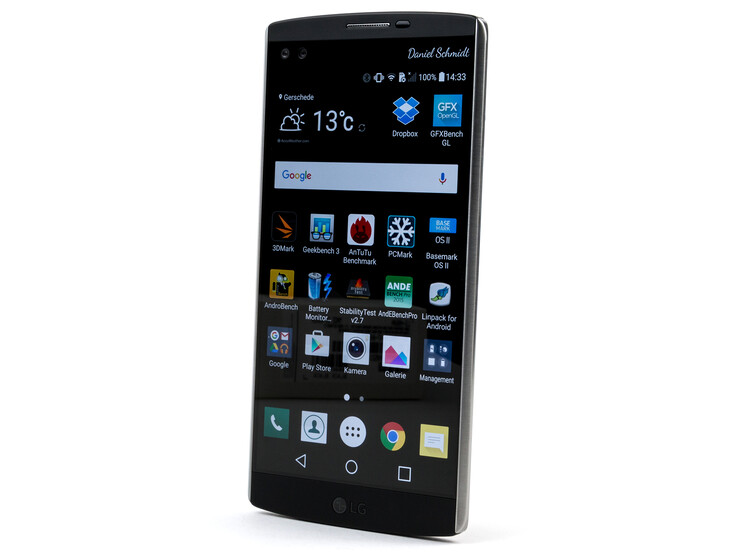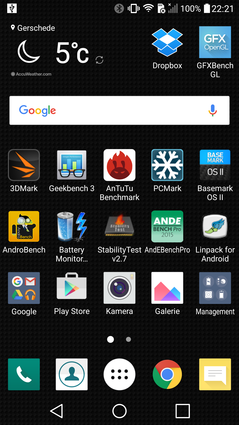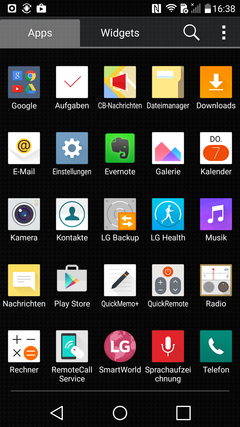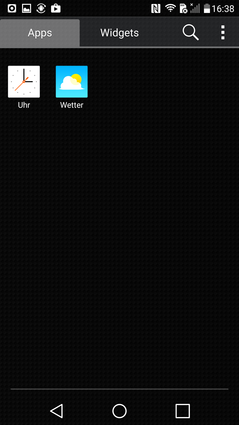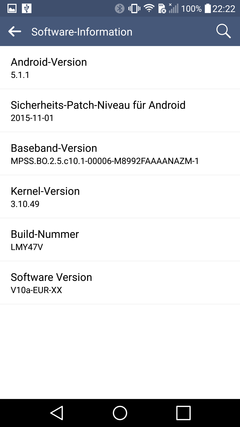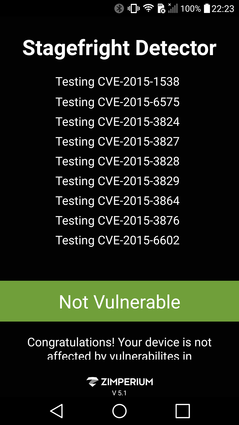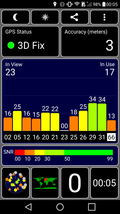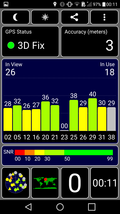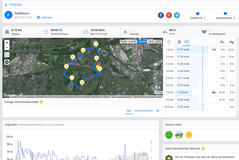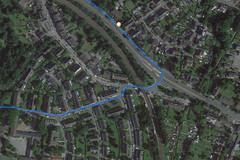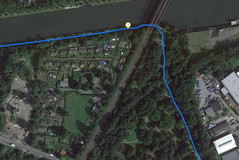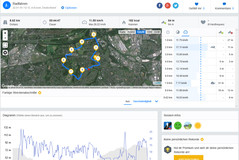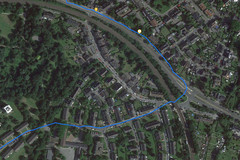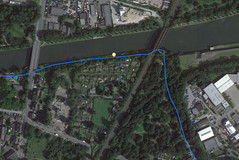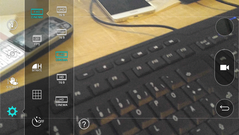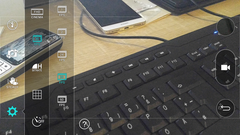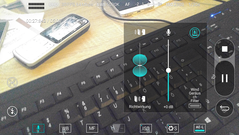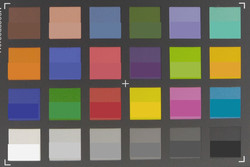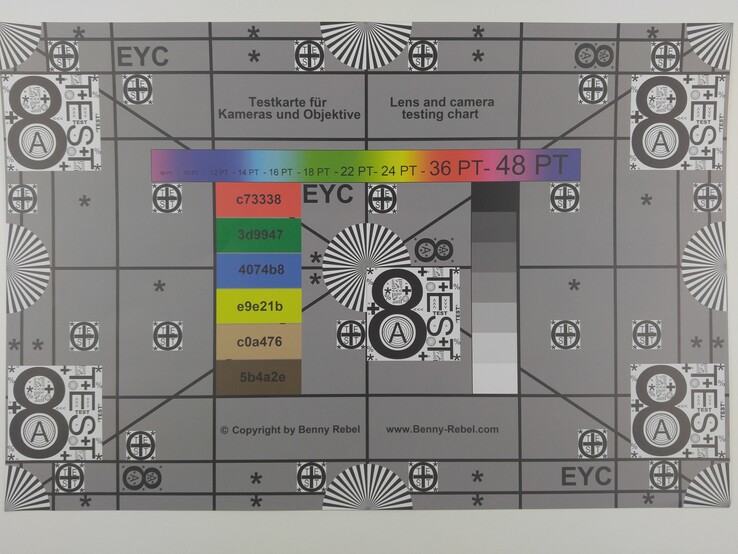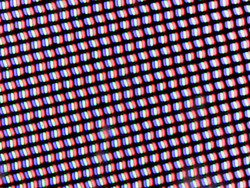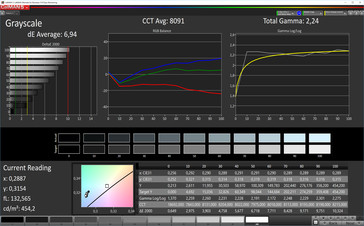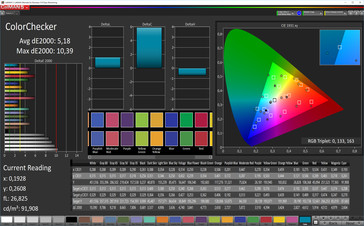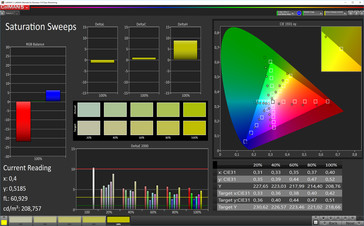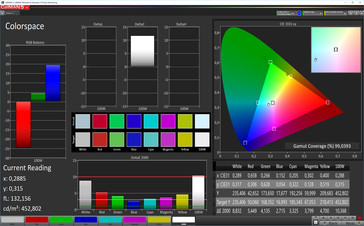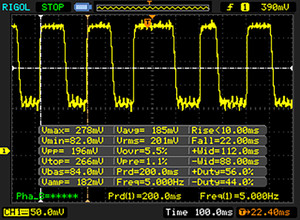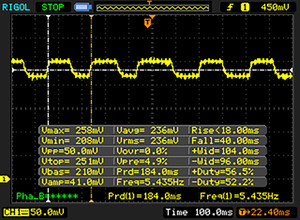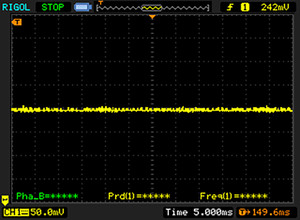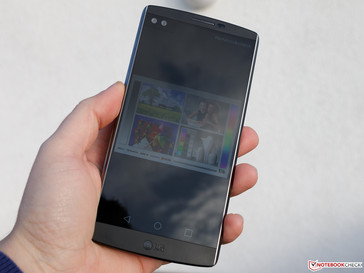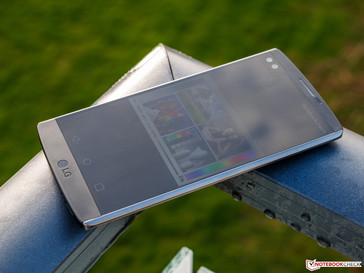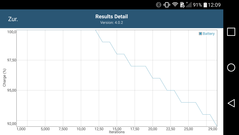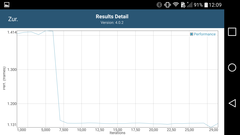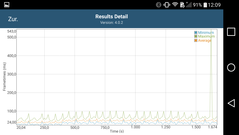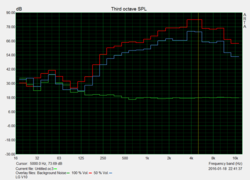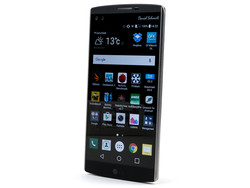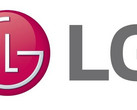LG V10 Smartphone Review
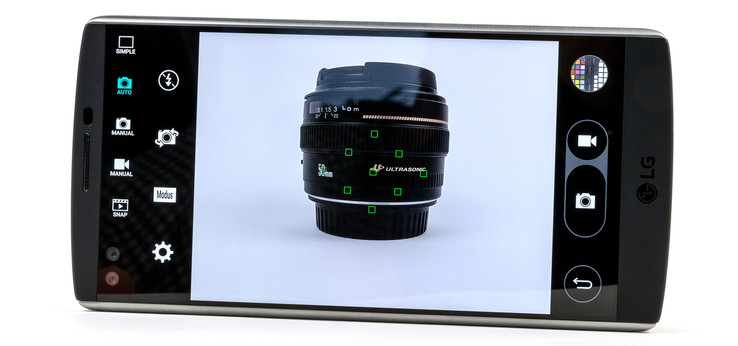
For the original German review, see here.
With its V10, LG has launched a smartphone on the market that is technically very similar to LG's G4. However, its design has been completely revised, and the 5.7-inch screen is slightly larger. In addition, a second screen is situated above the primary panel that displays brief information. The front-facing camera now comes with two lenses. A Snapdragon 808 clocks inside. The working memory has been increased to 4 GB. The rest is familiar and does not present us with any innovations. It is rather surprising that LG demands a relatively high price of approximately 649 Euros (~$727) for the V10 - especially since its successor is to be launched in a few weeks.
In addition to the company's own LG G4 smartphone, handsets like Microsoft's Lumia 950 XL, Motorola's Moto X Style, Google's Nexus 6P and Samsung's Galaxy S6 Edge+ are among the rivals. They all have a large screen and can present high-end specifications.
Case
LG's V10 is not only larger because of its screen; it also looks bulkier and very robust. In fact, LG advertises the smartphone as particularly resistant. It is supposedly two and a half times more stable than a conventional smartphone. However, the manufacturer remains quiet on just exactly what this means. In any case, the handset does not fulfil any special specifications.
LG's V10 easily defies warping attempts, and does not produce noises while doing so. Only firm pressure on the Corning Gorilla Glass 4 protected screen leads to minor wave formation. The gaps are accurate and do not give any reason for complaint. The looks of the dotted back cover is certainly a matter of taste, but it proves to be insusceptible to fingerprints. It is slip-proof and provides a good grip even on sleek surfaces.
The back cover is removable, and reveals the replaceable battery, as well as the Nano-SIM and micro-SD card slots. The smartphone is also available in white; more color options are to follow.
Connectivity
LG is not tight-fisted in terms of connectivity, and has installed several features in its V10 that no high-end smartphone should be without. The Korean manufacturer still relies on only a micro-USB port rather than a more modern Type-C interface. However, the integrated port supports OTG, making it possible to connect external peripherals and flash drives, as well as SlimPort. The latter enables connecting the smartphone to an HDMI port via an optional adapter, and to directly render the content on, for example, a TV screen.
Bluetooth 4.1, NFC, Miracast, Wi-Fi Direct and an IR transmitter are also installed. Typical of LG, several devices, such as TVs, players, Hi-Fi systems, projectors or air conditioners can be controlled via the infrared sensor in conjunction with the Quick Remote app.
Software
Google's Android 5.1.1 Lollipop powers LG's V10. The manufacturer covers it with its own user interface. It is to be updated to the latest Android 6.0, but no date has yet been set.
The apps have not changed that much compared with LG's G4: Only a few third-party apps are preloaded, and they can be uninstalled quickly and easily. LG has also installed several proprietary apps.
Communication & GPS
The Wi-Fi module in LG's V10 supports the IEEE 802.11 a/b/g/n/ac standards, and consequently the 2.4 and 5.0 GHz frequency bands. The connection range was good in the test, and no significant irregularities were observed. The smartphone just could not really utilize its full potential in terms of transmission speed. It never achieved more than 72 MBit/s in the test, and when it had a choice, used the 2.4 GHz network exclusively.
LG's V10 accesses the mobile Internet via HSPA+ (max. 42 MBit/s) or LE Cat 6 (max. 300 MBit/s). The LTE frequency coverage is rather unsatisfactory, and is limited to the bare necessities. Nevertheless, it is sufficient in Europe.
The GPS and GLONASS satellite networks are used to determine positioning, which is relatively fast and accurate even indoors. The deviations in tracking accuracy are lower outdoors, and our position was found faster.
LG's V10 has to compete with the Garmin Edge 500 bicycle navigation system to determine its position accuracy. Both devices record the route on a bike trip. The smartphone is not quite as accurate as the navigation system and tends to take shortcuts. However, just 100 meters (~328 ft) over the entire route is acceptable.
Call Quality
The phone app is already familiar from LG's G4, and only its colors have been slightly modified. LG's V10 takes a big step forward in terms of phone acoustics when holding the handset directly to the ear. It does not give any reason for complaint here, and the user will experience a good voice quality. The situation is different when using the speaker. While we could understand our contact well and the voice only sounded a little hollow, the acoustic at the other end was moderate. We were barely perceptible and sounded as if we had a bad cold (nasal). It also echoed so strongly that word parts were completely swallowed.
Cameras
A dual-lens camera is situated on the front of LG's V10. It has a resolution of up to 5 MP (2560x1440 pixels). Unlike many other dual-lenses, the images of both sensors are not combined. Instead, the user can choose between two different camera angles. While one offers an 80 degree angle, the other offers 120 degrees. The latter is particularly handy when taking panoramic selfies. The image quality is acceptable. Although the camera has a fixed focus, it supports HDR that also makes backlit photos possible.
The rear-facing primary camera is identical to the one in LG's G4 on the specification sheet, and its quality is also equal to that. The photos are quite good in automatic mode, and primarily the HDR feature is used sensibly. Unfortunately, a light grayish haze is produced in dark areas, and details look slightly blurred. The photos are razor-sharp in manual mode, and they appeal to us even more. LG could work on the software a bit here. LG's V10 still produces good results in low-light, which is primarily due to the large aperture (f/1.8), but the lens cannot compete with the low-light performance of the Lumia 950 XL.
Videos can be recorded in 2160p (max. 30 FPS), 1080p (max. 60 FPS) or 720p (max. 120 FPS). The biggest modifications compared with LG's G4 are found here. The manual video mode has been primped significantly. The audio qualities in particular have been greatly improved. The V10 now has three microphones with three sensitivity levels, as well as wind noise suppression. The image quality in Full HD is really good, but UHD never looks quite smooth. The auto focus could also be faster in the highest resolution.
Color Accuracy & Sharpness
We made an as full-frame as possible screenshot of ColorChecker Passport under controlled light conditions to better assess the color accuracy of LG's V10. Only the smartphone's automatic mode is used, and the pictures are not edited afterwards. Brown and skin tones are quite natural, but unfortunately, richer colors look rather pale and the grayscale levels could also be more saturated.
We evaluated the sharpness with a test chart that is also photographed as full-frame as possible in artificial light. It is very obvious that the sharpness decreases toward the picture's edges, and the image also fades slightly. The image is agreeably sharp in the center. Minor artifacts are seen in the text on colored surfaces, which is only visible on a full-sized photo.
Accessories & Warranty
LG's V10 comes with a modular power supply that has a nominal output of 9 watts (5 volts, 1.8 ampere), a USB cable, a printed quick-start guide, and a Quad-Beat 3 headphone optimized by AKG.
The manufacturer includes a 24-month warranty on its product, which cannot be extended.
Input Devices & Handling
The capacitive touchscreen in LG's V10 identifies up to ten fingers at a time. The Corning Gorilla Glass 4 surface has good gliding qualities and responds very reliably up into the corners. Inputs are also implemented quite fast. LG's UI appears to have gained a little performance. However, the odd stutter is still seen occasionally.
Like LG's G4, the power and volume controls are on the smartphone's back where they are easy to reach with the index finger. A fingerprint scanner is also integrated in the power button. It responded very reliably and quickly in the test. The smartphone's large size makes one-handed use rather awkward. However, handling the V10 is still relatively convenient when the displayed contents' size is reduced via swiping over the control bar.
The keyboard's layout is also familiar from the G4, and it is very well-designed. Some space is wasted only in landscape mode. Users can download other variants from the Play Store when preferred.
Display

A special feature of LG's V10 is its two screens. The primary panel has a size of 5.7 inches and a resolution of 2560x1440 pixels. The resulting pixel density of 513 PPI ensures a sharp reproduction of the contents. The second screen is on the front-facing cameras' right, directly above the large screen. Both screens are so close to each other that only on close inspection it becomes evident that they are two separate components. The small panel has a size of 2.1 inches (160x1040 pixels) and the same resolution as the larger screen. Its illumination is not quite as homogeneous as that of the primary screen, and slight clouding is visible at the edges in the dark. Subjectively, no difference is noticed in the daylight. The so-called Second Screen Display serves as a notification center, enabling quick access to favorite contacts and apps, controlling the music player and managing calendar entries. Unfortunately, it takes just as much effort as when using the primary screen, and thus we do not really see an added value here. We would wish for more customization options and, above all, an easier way to act directly from a locked screen. Whether LG will add this via an update is not known.
The Korean manufacturer has done a very good job in terms of the primary screen. It is pleasantly bright with up to 450 cd/m². In conjunction with a low black level of just 0.22 cd/m², it achieves a tremendous contrast ratio that currently only OLED panels surpass. We also checked whether the rates stand up to more realistic conditions when dark and light areas are evenly distributed. However, the rates are identical, even at APL50.
| |||||||||||||||||||||||||
Brightness Distribution: 93 %
Center on Battery: 450 cd/m²
Contrast: 2045:1 (Black: 0.22 cd/m²)
ΔE ColorChecker Calman: 5.18 | ∀{0.5-29.43 Ø4.77}
ΔE Greyscale Calman: 6.94 | ∀{0.09-98 Ø5}
Gamma: 2.24
CCT: 8091 K
| LG V10 Adreno 418, 808 MSM8992, 32 GB eMMC Flash | LG G4 Adreno 418, 808 MSM8992, 32 GB eMMC Flash | Microsoft Lumia 950 XL Adreno 430, 810 MSM8994, 32 GB eMMC Flash | Motorola Moto X Style Adreno 418, 808 MSM8992, 32 GB eMMC Flash | Google Nexus 6P Adreno 430, 810 MSM8994, 32 GB eMMC Flash | Samsung Galaxy S6 Edge+ Mali-T760 MP8, Exynos 7420, 32 GB UFS 2.0 Flash | |
|---|---|---|---|---|---|---|
| Screen | -17% | 18% | -17% | 21% | 14% | |
| Brightness middle (cd/m²) | 450 | 566 26% | 297 -34% | 538 20% | 363 -19% | 335.7 -25% |
| Brightness (cd/m²) | 431 | 536 24% | 297 -31% | 528 23% | 365 -15% | 332 -23% |
| Brightness Distribution (%) | 93 | 90 -3% | 93 0% | 92 -1% | 90 -3% | 89 -4% |
| Black Level * (cd/m²) | 0.22 | 0.47 -114% | 0.66 -200% | |||
| Contrast (:1) | 2045 | 1204 -41% | 815 -60% | |||
| Colorchecker dE 2000 * | 5.18 | 6.17 -19% | 2.67 48% | 2.63 49% | 2.34 55% | 2.33 55% |
| Colorchecker dE 2000 max. * | 10.39 | 3.98 62% | ||||
| Greyscale dE 2000 * | 6.94 | 6.26 10% | 2.81 60% | 3.24 53% | 1.03 85% | 2.15 69% |
| Gamma | 2.24 98% | 2.48 89% | 2.08 106% | 2.17 101% | 2.23 99% | 2.15 102% |
| CCT | 8091 80% | 8171 80% | 6379 102% | 6906 94% | 6429 101% | 6184 105% |
| Color Space (Percent of AdobeRGB 1998) (%) | 65.48 | 66.31 | ||||
| Color Space (Percent of sRGB) (%) | 98.63 | 99.79 |
* ... smaller is better
The color accuracy of the screen in LG's V10 could be better for a premium smartphone. The measured average DeltaE rates are only mediocre. However, there are also some peaks. For example, the dE sometimes climbs to 10 in the grayscale and displays a visible cyan tint. This is also reflected in the panel's relatively high color temperature. These apparent shifts are not present in reproduced colors. However, this is not noticeable in everyday use.
Display Response Times
| ↔ Response Time Black to White | ||
|---|---|---|
| 32 ms ... rise ↗ and fall ↘ combined | ↗ 10 ms rise | |
| ↘ 22 ms fall | ||
| The screen shows slow response rates in our tests and will be unsatisfactory for gamers. In comparison, all tested devices range from 0.1 (minimum) to 240 (maximum) ms. » 85 % of all devices are better. This means that the measured response time is worse than the average of all tested devices (20.2 ms). | ||
| ↔ Response Time 50% Grey to 80% Grey | ||
| 58 ms ... rise ↗ and fall ↘ combined | ↗ 18 ms rise | |
| ↘ 40 ms fall | ||
| The screen shows slow response rates in our tests and will be unsatisfactory for gamers. In comparison, all tested devices range from 0.165 (minimum) to 636 (maximum) ms. » 94 % of all devices are better. This means that the measured response time is worse than the average of all tested devices (31.6 ms). | ||
Screen Flickering / PWM (Pulse-Width Modulation)
| Screen flickering / PWM not detected | |||
In comparison: 53 % of all tested devices do not use PWM to dim the display. If PWM was detected, an average of 8081 (minimum: 5 - maximum: 343500) Hz was measured. | |||
Performance
LG's V10 is equipped with Qualcomm's Snapdragon 808 that is used in LG's G4 and many other smartphones. Although the hexa-core SoC is not as fast as the Snapdragon 810, it still has plenty of performance reserves and is currently one of the fastest SoCs that are installed in smartphones. A generously sized 4 GB LPDDR4 working memory supports the system, and the Adreno 418 GPU is responsible for calculating graphics.
The performance is on the expected level, and the V10 is even slightly faster than the G4 in the benchmarks. However, the Moto X Style that is based on the same SOC is even faster. The rival calculates 3DMark Physics in particular by up to 17% faster. It is quite possible that this is due to LG's user interface since, unlike the V10, the Moto X relies on a pure Android operating system.
| Geekbench 3 | |
| 64 Bit Single-Core Score (sort by value) | |
| LG V10 | |
| LG G4 | |
| Motorola Moto X Style | |
| Google Nexus 6P | |
| Samsung Galaxy S6 Edge+ | |
| 64 Bit Multi-Core Score (sort by value) | |
| LG V10 | |
| LG G4 | |
| Motorola Moto X Style | |
| Google Nexus 6P | |
| Samsung Galaxy S6 Edge+ | |
| 3DMark | |
| 1280x720 offscreen Ice Storm Unlimited Score (sort by value) | |
| LG V10 | |
| LG G4 | |
| Motorola Moto X Style | |
| Google Nexus 6P | |
| Samsung Galaxy S6 Edge+ | |
| 1280x720 offscreen Ice Storm Unlimited Graphics Score (sort by value) | |
| LG V10 | |
| LG G4 | |
| Motorola Moto X Style | |
| Google Nexus 6P | |
| Samsung Galaxy S6 Edge+ | |
| 1280x720 offscreen Ice Storm Unlimited Physics (sort by value) | |
| LG V10 | |
| LG G4 | |
| Motorola Moto X Style | |
| Google Nexus 6P | |
| Samsung Galaxy S6 Edge+ | |
| 2560x1440 Sling Shot OpenGL ES 3.0 (sort by value) | |
| LG V10 | |
| LG G4 | |
| Motorola Moto X Style | |
| Google Nexus 6P | |
| Samsung Galaxy S6 Edge+ | |
| 2560x1440 Sling Shot OpenGL ES 3.0 Graphics (sort by value) | |
| LG V10 | |
| LG G4 | |
| Motorola Moto X Style | |
| Google Nexus 6P | |
| Samsung Galaxy S6 Edge+ | |
| 2560x1440 Sling Shot OpenGL ES 3.0 Physics (sort by value) | |
| LG V10 | |
| LG G4 | |
| Motorola Moto X Style | |
| Google Nexus 6P | |
| Samsung Galaxy S6 Edge+ | |
| GFXBench 3.0 | |
| on screen Manhattan Onscreen OGL (sort by value) | |
| LG V10 | |
| LG G4 | |
| Microsoft Lumia 950 XL | |
| Motorola Moto X Style | |
| Google Nexus 6P | |
| Samsung Galaxy S6 Edge+ | |
| 1920x1080 1080p Manhattan Offscreen (sort by value) | |
| LG V10 | |
| LG G4 | |
| Microsoft Lumia 950 XL | |
| Motorola Moto X Style | |
| Google Nexus 6P | |
| Samsung Galaxy S6 Edge+ | |
| PCMark for Android - Work performance score (sort by value) | |
| LG V10 | |
| LG G4 | |
| Motorola Moto X Style | |
| Google Nexus 6P | |
| Samsung Galaxy S6 Edge+ | |
| Smartbench 2012 | |
| Productivity Index (sort by value) | |
| LG V10 | |
| LG G4 | |
| Motorola Moto X Style | |
| Google Nexus 6P | |
| Samsung Galaxy S6 Edge+ | |
| Gaming Index (sort by value) | |
| LG V10 | |
| LG G4 | |
| Motorola Moto X Style | |
| Google Nexus 6P | |
| Samsung Galaxy S6 Edge+ | |
| GFXBench (DX / GLBenchmark) 2.7 | |
| T-Rex Onscreen (sort by value) | |
| LG V10 | |
| LG G4 | |
| Microsoft Lumia 950 XL | |
| Motorola Moto X Style | |
| Google Nexus 6P | |
| 1920x1080 T-Rex Offscreen (sort by value) | |
| LG V10 | |
| LG G4 | |
| Microsoft Lumia 950 XL | |
| Motorola Moto X Style | |
| Google Nexus 6P | |
| Linpack Android / IOS | |
| Single Thread (sort by value) | |
| LG V10 | |
| LG G4 | |
| Microsoft Lumia 950 XL | |
| Motorola Moto X Style | |
| Google Nexus 6P | |
| Multi Thread (sort by value) | |
| LG V10 | |
| LG G4 | |
| Microsoft Lumia 950 XL | |
| Motorola Moto X Style | |
| Google Nexus 6P | |
Seen purely subjectively, LG's V10 does not slip up when browsing on the Internet. It is, however, somewhat slower than its rivals. The smartphone primarily shows its slow side in the WebXPRT 2015, Kraken 1.1 and Jetstream benchmarks. The comparison field is much closer together in Google's benchmarks.
| WebXPRT 2015 - Overall (sort by value) | |
| LG V10 | |
| LG G4 | |
| Microsoft Lumia 950 XL | |
| Motorola Moto X Style | |
| Google Nexus 6P | |
| Samsung Galaxy S6 Edge+ | |
| Octane V2 - Total Score (sort by value) | |
| LG V10 | |
| LG G4 | |
| Microsoft Lumia 950 XL | |
| Motorola Moto X Style | |
| Google Nexus 6P | |
| Samsung Galaxy S6 Edge+ | |
| JetStream 1.1 - Total Score (sort by value) | |
| LG V10 | |
| LG G4 | |
| Microsoft Lumia 950 XL | |
| Motorola Moto X Style | |
| Google Nexus 6P | |
| Samsung Galaxy S6 Edge+ | |
| Mozilla Kraken 1.1 - Total (sort by value) | |
| LG V10 | |
| LG G4 | |
| Microsoft Lumia 950 XL | |
| Motorola Moto X Style | |
| Google Nexus 6P | |
| Samsung Galaxy S6 Edge+ | |
| Google V8 Ver. 7 - Google V8 Ver. 7 Score (sort by value) | |
| LG V10 | |
| LG G4 | |
| Microsoft Lumia 950 XL | |
| Motorola Moto X Style | |
| Google Nexus 6P | |
| Samsung Galaxy S6 Edge+ | |
| BaseMark OS II - Web (sort by value) | |
| LG V10 | |
| LG G4 | |
| Microsoft Lumia 950 XL | |
| Motorola Moto X Style | |
| Google Nexus 6P | |
| Samsung Galaxy S6 Edge+ | |
* ... smaller is better
A 32 GB internal eMMC flash memory is installed in LG's V10. Approximately 22 GB is available after booting the handset for the first time. The storage can be expanded via a micro-SD card should this not be enough. LG states that up to 2 TB would be possible. However, currently memory cards with a maximum of 200 GB exist. The review sample supports moving app data to the optional additional storage (App2SD).
We tested the card slot's speed with the fast Exceria SD-CX32UHS1 memory card (max. 95 MB/s read, 60 MB/s write). The card reader still managed a write speed of 34 MB/s; read was performed at 84 MB/s. Very good rates are primarily achieved in read performance, while the write speed is only average.
As expected, the internal storage is much faster and delivers good rates in AndroBench. Although it is not as fast as the UFS storage in the Galaxy S6 Edge+, it should hardly be noticed in everyday use. Once again, the review sample displays minor weaknesses in the write rates here.
| AndroBench 3-5 | |
| Sequential Read 256KB (sort by value) | |
| LG V10 | |
| LG G4 | |
| Motorola Moto X Style | |
| Google Nexus 6P | |
| Samsung Galaxy S6 Edge+ | |
| Sequential Write 256KB (sort by value) | |
| LG V10 | |
| LG G4 | |
| Motorola Moto X Style | |
| Google Nexus 6P | |
| Samsung Galaxy S6 Edge+ | |
| Random Read 4KB (sort by value) | |
| LG V10 | |
| LG G4 | |
| Motorola Moto X Style | |
| Google Nexus 6P | |
| Samsung Galaxy S6 Edge+ | |
| Random Write 4KB (sort by value) | |
| LG V10 | |
| LG G4 | |
| Motorola Moto X Style | |
| Google Nexus 6P | |
| Samsung Galaxy S6 Edge+ | |
Games
LG's V10 is equipped with a premium-range graphics unit, and is thus also quite suitable for gaming. Despite the screen's high resolution, no significant lags occur even in "Asphalt 8", while less demanding games like "Candy Crush Jelly" are never a problem for the phablet.
The touchscreen and the impeccably functioning sensors complete the gaming enjoyment. Only the speaker's position is not ideal in landscape mode.
Emissions
Temperature
The idle surface temperatures of LG's V10 of up to 32 °C (~90 °F) are uncritical. The rates climbed to over 40 degrees (~104 °F) primarily on large areas of the back. However, that was never unpleasant or disconcerting.
We used the battery test of GFXBench 4.0 to check the temperature development under the hood. Here, the OpenGL ES 2.0 T-Rex test is run thirty times in succession, and both the battery charge state and the frame rates are recorded. Surprisingly, the review sample does a worse job than LG's G4, which displays performance losses after 25 runs. The V10's performance abruptly dropped by 20% at the beginning of the sixth run.
(±) The maximum temperature on the upper side is 41 °C / 106 F, compared to the average of 35.2 °C / 95 F, ranging from 21.9 to 247 °C for the class Smartphone.
(±) The bottom heats up to a maximum of 41.2 °C / 106 F, compared to the average of 34 °C / 93 F
(+) In idle usage, the average temperature for the upper side is 30.3 °C / 87 F, compared to the device average of 32.9 °C / 91 F.
System Noise
LG's V10 is absolutely silent unless it is prompted. However, that is different for our review sample's included power supply. It starts to whine after a few minutes when recharging the handset. This is very annoying especially in quiet surroundings.
Speaker
The speaker is situated on the lower edge of LG's V10 smartphone. It allows placing the handset on a table without having to worry about restricting the sound. The component cannot be covered when holding the handset in a hand, either.
The phablet can get really loud with up to 90 dB(A). Then again, the sound impression is not very balanced and the upper mids could distort slightly here. The bass range and lower mids are virtually non-existent.
Users who like to listen to music on the go could be very happy with LG's V10. Although the included headphones are only average quality, the smartphone features a 32 bit Hi-Fi D-A converter that enhances poor quality audio files and provides a clear sound impression at the audio jack. It is in fact very good and cannot be criticized. However, the promise of supporting especially high-quality headphones (50 - 600 ohms) should be taken with a pinch of salt because they only manage a low volume in conjunction with the smartphone. The audio jack does not have enough voltage to compensate high resistances.
Energy Management
Power Consumption
The power consumption of LG's V10 is at a good level, particularly in idle mode, and does not give any reason for complaint. As we have previously observed in other flagships by LG, the smartphone has a relatively high requirement during full load. The power supply is a bit tight, but still recharges the smartphone even during full load.
The handset requires 0.21 watts in standby when the second screen is disabled. The energy requirement climbs by 0.05 watts when it is turned on. The second screen needs about 0.13 watts when using the smartphone, which is very little.
LG's smartphone supports Quick Charge and can fully recharge the phablet within 75 minutes. The 3000 mAh battery is recharged by 50% in just 30 minutes.
| Off / Standby | |
| Idle | |
| Load |
|
Key:
min: | |
Battery Runtime
Despite the relatively small battery, LG's V10 does quite a good job in the comparison field and beats the smaller G4 model in all sectors. The long runtimes in the Reader's test are achieved thanks to the screen's very low minimum brightness of not even 4 cd/m². This not only spares the battery, but also the eyes at night.
The review sample cannot compete with any of its rivals in the more significant "browsing via Wi-Fi" test using a screen brightness of 150 cd/m². The small battery is noticed here. Nevertheless, the runtimes are just below those of the Lumia 950 XL (3340 mAh) and the Nexus 6P (3450 mAh). Samsung's smartphone is out of the V10's reach.
| LG V10 Adreno 418, 808 MSM8992, 32 GB eMMC Flash | LG G4 Adreno 418, 808 MSM8992, 32 GB eMMC Flash | Microsoft Lumia 950 XL Adreno 430, 810 MSM8994, 32 GB eMMC Flash | Google Nexus 6P Adreno 430, 810 MSM8994, 32 GB eMMC Flash | Samsung Galaxy S6 Edge+ Mali-T760 MP8, Exynos 7420, 32 GB UFS 2.0 Flash | Motorola Moto X Style Adreno 418, 808 MSM8992, 32 GB eMMC Flash | |
|---|---|---|---|---|---|---|
| Battery runtime | -15% | -8% | 7% | 12% | -10% | |
| Reader / Idle (h) | 28.3 | 27.6 -2% | 18 -36% | 24.1 -15% | 24.3 -14% | 19 -33% |
| H.264 (h) | 9 | 8.4 -7% | 10.2 13% | 8.9 -1% | 6.4 -29% | |
| WiFi v1.3 (h) | 5.9 | 5.4 -8% | 6.2 5% | 6.3 7% | 8.4 42% | 6.7 14% |
| Load (h) | 3.4 | 1.9 -44% | 3 -12% | 4.7 38% | 3.7 9% | 3.7 9% |
Pros
Cons
Verdict
With the LG V10, the Korean manufacturer provides another superb smartphone that is very similar to LG's G4 on the specification sheet, but does not have much in common with its sister model in terms of looks. Selfie fans will certainly like the front-facing dual-lens. The second screen is nice to have, but its potential is not fully utilized, and most actions are performed just as fast via the primary screen.
The V10 also features a good fingerprint scanner that has been integrated inconspicuously in the power button on the back. Otherwise, LG also does a good job and has improved the screen that is familiar from the G4, which now has a tremendously high contrast, among other things. The features of the very good camera have been developed even further, but unfortunately, the manufacturer has failed to improve the automatic mode.
LG presents yet another strong smartphone with its V10. Its biggest shortcoming is the high market price.
The choice is ultimately a question of taste and budget when having to opt for one LG's flagship models. The V10 costs approximately 200 Euros (~$224) more than the G4, whose price has in the meantime dropped significantly.
LG V10
- 02/02/2016 v4.1 (old)
Daniel Schmidt


